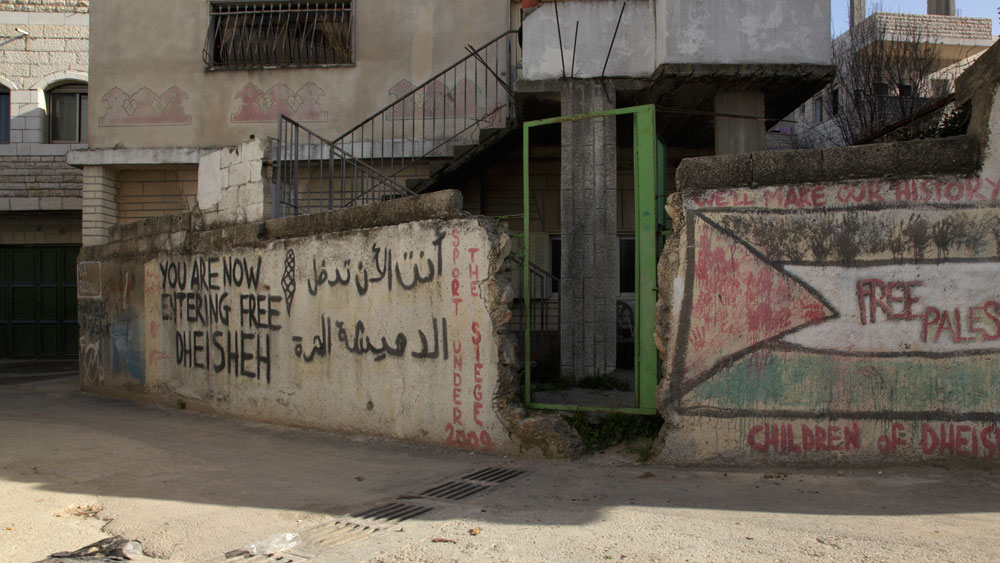First Palestinian museum in US opens April 22
Located in a 4,000 square foot gallery outside of New Haven, Connecticut, the new Palestine Museum US may seem like a modest venture. But Faisal Saleh’s labor of love is in fact a groundbreaking project in Palestinian cultural preservation in the diaspora.
As the first Palestinian-focused art museum in the United States, it is entirely managed by Palestinians, and will showcase works by artists from Palestine and the diaspora.
The opening exhibition features visual art from nine artists as well as select historical pieces like passports from pre-1948 Palestine. The contents of the gallery are diverse, ranging from geometric abstract paintings by renowned artist Samia Halaby, to the portraits by the young Gazan painter Malak Mattar. A series of photographs by Margaret Olin displays the conditions in West Bank refugee camps and the popular art that adorns the walls there.
The entrance to the gallery features a mural, painted by Ayed Arafah of Ramallah, which honors Rachel Corrie. Corrie was a young American woman killed by Israeli forces in 2003 while trying to stop the demolition of a Palestinian home.
Saleh, the founder of the museum, grew up in El Bireh outside of Ramallah in the West Bank. His family, having lost everything in the Nakba, the Palestinian catastrophe of 1948, endured impoverished conditions throughout his childhood. Nonetheless, Saleh thrived, and moved to Pennsylvania for his final year of high school before attending Oberlin College. He has worked in the employee benefits field since 1974, started his own business in 1985, and now owns half of a boutique consulting firm.
On the topic of funding and affiliations, Saleh is clear: the museum must be “purely Palestinian,” without outside influences, political or religious affiliations, or connections with other organizations. This is part of the reason why he has personally funded the project’s initial phase, and is now seeking other Palestinian individual donors to contribute.
“We feel that moving the dialogue or the discourse from the political arena to the artistic and cultural arena can be more beneficial and more effective,” Saleh says.
“The Palestinians have been dehumanized and portrayed in very negative ways. Our job is to show that Palestinians are human, like everybody else, and they have thousands of artists, they excel in the arts.”
The fact that the global Palestinian community includes many thousands of talented artists is no exaggeration: the planning of the museum began less than a year ago, but Saleh says he already has more artwork than he can display in the gallery. Following outreach in Palestine and elsewhere about the museum, hundreds of artists worldwide have contacted him, eager to participate. This gives him hope for the next stage of the museum. Saleh wants to move into a larger space in a major city. Eventually, he hopes to establish locations throughout the country and even internationally.
For now, Saleh says that most of the work is being done by a handful of people, all of whom are volunteering their time. They have hired a local gallery’s staff to handle the shipping and installation of items, but do the outreach and publicity themselves. The museum has been featured in local news media and has a sizable social media following.
Participating artist, the renowned Samia Halaby, was born in Jerusalem in 1936 and forced out of Palestine during the Nakba as a child, Halaby came to the US in 1951. She is now an influential abstract artist, and her work has been displayed in the world-famous Guggenheim art museum in New York, the Art Institute of Chicago, the British Museum, and other galleries worldwide.
Halaby is also a lifelong advocate for the Palestinian cause, and has published numerous books and articles about Palestinian art history. Her most recent book, Drawing the Kafr Qassem Massacre,is a series of drawings based on interviews with survivors of the killing of dozens of Palestinian workers by Israel in 1956.
“I admire Palestinians who keep building, and allowing our progress as human beings on this earth — culturally, in the sciences and all areas of thought, building organizations,” Halaby says of the museum initiative.
“When I heard about the Palestine Museum US, I was enthusiastic. I visited the museum, met [Saleh], and was impressed with what I saw and with his sincerity, so I support him and I support the project.”
Halaby’s pieces in the gallery include “Our Beautiful Lands Stolen in the Dark of History.” She will also give the keynote address at the private opening ceremony on April 22.
Saleh notes that above all, the museum will be a Palestinian space.
“The Palestinians are our first audience. Whether they are in the US, or in Palestine, or in the diaspora, we want the Palestinians to have a place that they feel is their own, and that they can be proud of, and they can see it as a Palestinian institution that is excelling at showcasing the Palestinian arts.”
Anyone interested in supporting the museum or getting involved can contact the museum through the official Facebook page or on the contact page of their website.




